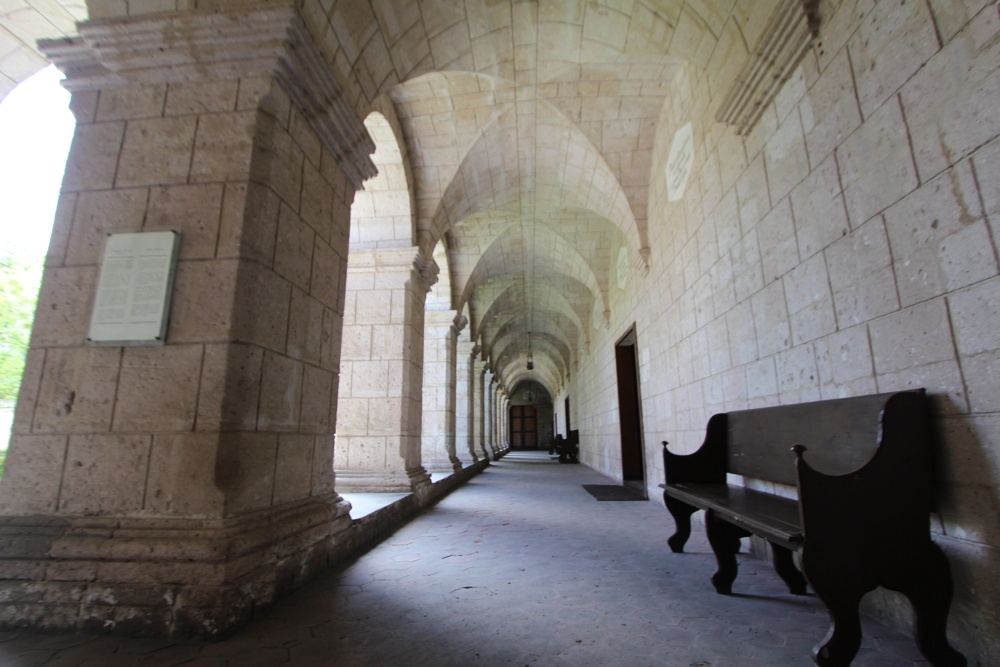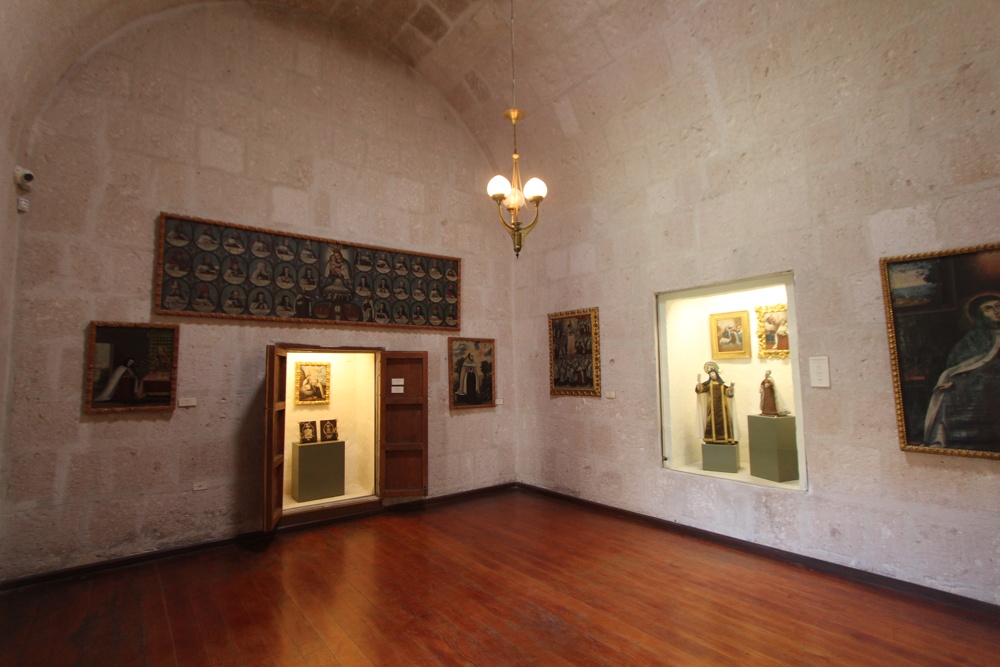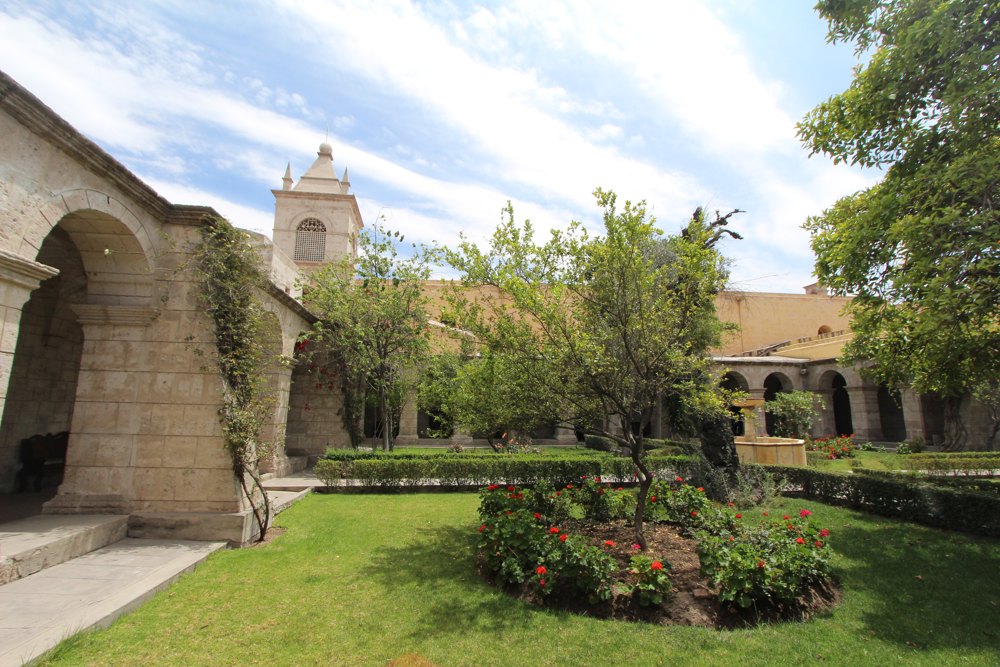Arequipa is easily one of the most charming cities in all of Peru, home to gleaming-white historic buildings made from volcanic ash, sillar, grand religious monasteries, and a rich cultural scene – hosting the annual literary Hay Festival. One of the city’s key attractions is Santa Teresa Monastery, a living-museum where cloistered nuns still reside to this day. Far less visited than nearby Santa Catalina Monastery, another major attraction and landmark in Arequipa, I had the opportunity to visit with one of Aracari’s specialist guides, Franz Grupp, the Monastery’s Director.
Santa Teresa Monastery Arequipa
Constructed in 1710, Santa Teresa Monastery is a smaller, lesser-known monastery compared to Santa Catalina, also in Arequipa. Santa Teresa hasn’t been open as long; almost 300 years after its foundation, it first opened its treasures to the public in 2005.
The Nuns of Santa Teresa Monastery
Santa Teresa has appeal in both the fact it functions as a comprehensive Museum of Viceregal Art, as well as a living museum: 15 cloistered Carmelite nuns still live here. These nuns remain inside the convent and do not interact with the outside world – they cannot be seen by tourists, nor see them. If you time your visit for midday, as I did, you can press your head against the wall and hear the nuns shuffle about as they head to prayer and listen to their melodic chants.
Santa Teresa’s Director Franz Grupp
The director of Santa Teresa, Franz Grupp, guided me around the monastery, talking me through the Viceregal art exhibited there. Franz is one of Aracari’s specialist guides, a veritable cultural expert, art historian and curator, who gives unparalleled insight into this historic site. Franz has been involved in important restoration projects throughout Peru, and was part of the team that presented the historical center of Arequipa to UNESCO to be regarded as a designated Cultural Heritage City, a status it achieved in 2000. Franz has studied paint and sculpture restoration in Peru, Italy, Spain, Brazil and Colombia and is additionally currently Director of Culture in Arequipa. From Santa Teresa’s historical past to future plans to attract more visitors (including Baroque concerts in the winter), Franz helped place the convent and its art into cultural context.
 Reconstruction following an earthquake
Reconstruction following an earthquake
Franz’s close involvement with Santa Teresa begun in 2001, when Arequipa was victim of a strong earthquake that cased damage to the Monastery. Along with his wife, he set about helping the nuns with rebuilding that was required, and asked the permission of the nuns to establish a Museum to restore and help protect their collection of artworks. It took them four years to establish the museum.
Explore Arequipa & Santa Teresa Monastery on our Highlgihts of Southern Peru itinerary!
Craftsmanship in the Monastery
The monastery visit began in an exhibition room that servers to explain the construction and decoration process of the monastery, including the various tools and examples from each stage. The display rooms takes you through the steps for wall painting, which was particularly informative in showcasing how intricate hand-painted decoration using natural dyes – seen elaborately on walls and ceilings elsewhere in the Monastery – is created over the buildings foundation of sillar (volcanic ash). It also showed how paintings were made and sculptures crafted. This set the context affording greater appreciation for the artworks we then went on to see throughout the rest of the monastery.
Viceregal Art
The monastery is divided into thirteen gallery rooms displaying hundreds of works of art. Franz commented that the Monastery has enough artwork in storage to re-do the Museum over two or three times! The rooms are themed, whether by retaining their original style or displaying a certain kind of art or artistry. The collections include sculptures, murals, precious metalworks, and religious art from the 16th, 17th, and 18th centuries. Some of the more conventional silver and gold pieces are still used regularly in the monastery’s daily activities. The Museum even has on display Chinese porcelain from the Wan Li dynasty – which was something I hadn’t expected to find in a monastery in Arequipa!
Forgotten Treasures
A highlight of the visit was seeing a staggeringly large hand-crafted navitity scene that was built perfectly to fit the size of an enormous trunk, and expanded to show this detailed nativity scene only upon opening. Franz recounted that before the Monastery became a museum, it had been kept closed with the keys lost for over 40 years. When Franz asked the younger nuns – who had been oblivious to the existence of the trunk’s contents – to find the keys, they returned with a collection of around 200 17-18th century era keys to try and open it with!
Santa Catalina Monastery and Santa Teresa Monastery
Santa Teresa is notably different from Santa Catalina, a far more visited monastery in Arequipa. Visits to both Santa Teresa and Santa Catalina complement each other. Santa Catalina is of the Dominican Order and effectively a city-within-a-city, with striking architecture including narrow, winding streets. Santa Teresa Monastery, on the other hand, is less notable for its architecture, but rather offers visitors the chance to see museum pieces and works of art and is home to objects you won’t find in Santa Catalina.
Visiting Santa Teresa Monastery with Aracari
Aracari arranges private, tailormade tours to Arequipa and Peru, optionally accompanied by Franz Grupp, the Director at Santa Teresa Monastery. Contact us today to plan your trip on travel@aracari.com.












 Reconstruction following an earthquake
Reconstruction following an earthquake